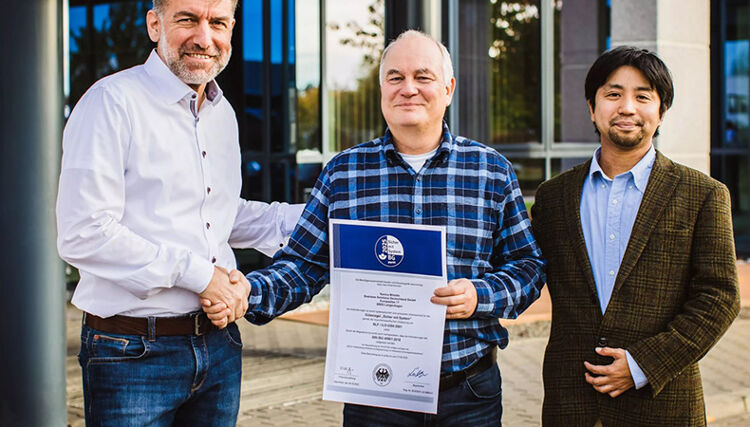How fair are LFP manufacturers to their employees and the environment?

Sonja Angerer emphasizes the importance for printers to buy from ethical companies if they want to invest sustainably.
On the 1st of January 2023, Germany introduced the Supply Chain Act. This act states that companies must ensure all human rights are respected by upstream suppliers when purchasing material and machinery. This currently only applies to companies with over 3,000 employees however, in 2024 this will be reduced to 1,000 employees. Therefore, most printers will only be affected by the second stages of implementation.
What is sustainability and how is it assessed?
Printers who are committed to sustainability should consider how their suppliers treat their employees and the environment. The definition of Agenda 21 states that sustainability is a bundle of measures that strives for ecological, social and economic goals in equal measure. The 2030 Agenda defines 17 sustainability goals, including "decent work and economic growth" (8), "health and well-being" (3) and "sustainable consumption and production" (12).
Manufacturers can no longer avoid enforcing measures for a more sustainable workspace. Since 207, large companies and major subsidiaries in Germany are obliged to prepare sustainability reports (CSR). The obligation will gradually be extended to include smaller, listed SMBs in the European Union by the end of the decade.
As early as the 2024, the CSR obligation will be applicable to companies that meet two of the following three criteria:
- Balance sheet total of 20 million euros or more
- Net sales of 40 million euros or more
- 250 employees or above
 CAPTION: EcoVadis certification can help identify sustainable investments in printing presses. Graphic EcoVadis: Via Epson, Background: S. Angerer
CAPTION: EcoVadis certification can help identify sustainable investments in printing presses. Graphic EcoVadis: Via Epson, Background: S. Angerer Fairness has many faces
EcoVadis as a benchmark for sustainable investing
- Environment
- Labour and human rights
- Ethics
- Sustainable procurement.
Corporate mission statements help printers with investment decisions
In 2015, the Board of Directors of the Durst Group adopted a "Code of Ethics and Conduct" for management and employees. This includes the pillars of "social and societal responsibility", "occupational health and safety" and environmental protection. As a Tyrolean company, Durst also wants to assume "social and societal responsibility for our environment".
The HP Integrity Guide focuses not only the human rights issues, but also how employees treat each other. It also contains recommendations for action and decision-making.
Canon's corporate philosophy is summarised by the term Kyosei. The term involves a balanced and future-orientated living and working together regardless of a person’s cultural background. Canon also aims to achieve net zero CO2 emissions by the year 2050.
Focus on occupational safety
The Austrian AUVA quality certification "Safe and Healthy at Work“ is a certificate for companies that show special commitment to health and safety at work. It confirms that health and safety working conditions have been implemented in the company.
 CAPTION: The Durst Group adopted a Code of Ethics and Conduct back in 2015. Pictured: Part of the company building in Lienz (AU). Photo: S. Angerer
CAPTION: The Durst Group adopted a Code of Ethics and Conduct back in 2015. Pictured: Part of the company building in Lienz (AU). Photo: S. Angerer "Soft" factors for sustainable investments are gaining in importance
For printers, the main argument remains surrounding technical features when investing in machinery. However, factors such as environmental awareness and fair work is likely to impact much later in future decision-making. This is likely to apply not only to printers with a CSR obligation, but to the industry as a whole.
This is due to the demand from print buyers who require high quality, prompt delivery as well as social and environmental responsibility. This makes it more difficult for printers to purchase machinery from manufactures with a credible stance on these issues. Therefore, investing sustainably becomes more challenging for the industry.
Main Image caption: f.l. Joerg Hartmann, Managing Director Konica Minolta Business
Solutions Germany & Austria; Steffen-Raymund Lübke, BGHW; Jiro Tanaka, Managing Director Konica Minolta Business Solutions Germany & Austria at the presentation of the "Sicher mit System" safety seal. Photo: Konica Minolta.
Topics
Interested in joining our community?
Enquire today about joining your local FESPA Association or FESPA Direct
Recent news

What are the opportunities for printers regarding backlit displays and window graphics?
Nessan Cleary describes the various opportunities for printers regarding window graphics. There is a wide range of materials and lighting options available.

What is the difference between labels and packaging regarding narrow web printing?
Nessan Cleary shares how labelling has always been distinct from packaging but increasingly lines are becoming blurred between them.

